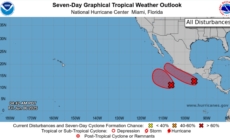-
Potential Tropical Storm Barbara Chances at Forming More Than Double - 12 mins ago
-
Commentary: At Sean ‘Diddy’ Combs trial, the women testifying are on trial too - 39 mins ago
-
David Beckham to Be Knighted by King Charles III - 40 mins ago
-
How to Watch Arizona vs North Carolina: Live Stream College Baseball Super Regionals, TV Channel - 48 mins ago
-
Recreational salmon fishing is resuming this weekend in California - about 1 hour ago
-
Republicans Propose ‘Natural Family Month’ To Boost Birth Rate - about 1 hour ago
-
Will White Men Rush to Court After Justices’ Latest Ruling? Not Likely. - about 1 hour ago
-
Walmart Lays Off Employees in Three States: What To Know - 2 hours ago
-
State moves to suspend licenses of troubled L.A. nursing home companies - 2 hours ago
-
Trump and Musk Trade Threats, From Broaching Impeachment to Cutting Contracts - 2 hours ago
Map: Cargo Ship With 3,000 Vehicles Abandoned Off Alaska Island
The crew of a cargo ship carrying thousands of vehicles from China to Mexico abandoned the vessel off Alaska’s Adak Island when they were unable to control a fire that broke out on board.
The Liberian-flagged Morning Midas ship is carrying 3,048 vehicles, including 70 electric models and 681 hybrids, the U.S. Coast Guard said.
It left Yantai, China, on May 26, industry site marinetraffic.com shows, destined for Lazaro Cardenas, a major Pacific port in Mexico.
There were no reported injuries among the 22 crew members of the Morning Midas, who were evacuated onto a lifeboat.
The crew initiated emergency firefighting procedures with the ship’s onboard fire suppression system. But they were unable bring the flames under control.
They were rescued by a nearby merchant vessel called the Cosco Hellas in the North Pacific, roughly 300 miles (490 kilometers) southwest of Adak, which is in Alaska’s Aleutian island chain.
Adak is about 1,200 miles (1,930 kilometers) west of Anchorage, the state’s largest city. The map below shows the ship’s last known location.
Ship’s Fire Status Unknown
A large plume of smoke was initially seen at the ship’s stern coming from the deck loaded with electric vehicles Tuesday, according to U.S. Coast Guard photos and a Wednesday statement from the ship’s management company, London-based Zodiac Maritime.
The Coast Guard said the Morning Midas is estimated to have approximately 350 metric tons of gas fuel and 1,530 metric tons of very low sulfur fuel oil onboard.
“The relevant authorities have been notified, and we are working closely with emergency responders with a tug being deployed to support salvage and firefighting operations,” Zodiac Maritime said in a statement.
“Our priorities are to ensure the continued safety of the crew and protect the marine environment.”
The U.S. Coast Guard said it sent aircrews to Adak and a ship to the area. The status of the fire onboard the ship was unknown as of Wednesday afternoon, but smoke was still emanating from it, according to the Coast Guard.

U.S. Coast Guard
“As the search and rescue portion of our response concludes, our crews are working closely with the vessel’s parent company, Zodiac Maritime, to determine the disposition of the vessel,” said Rear Admiral Megan Dean, commander of the Coast Guard’s Seventeenth District.
“We are grateful for the selfless actions of the three nearby vessels who assisted in the response and the crew of motor vessel Cosco Hellas, who helped save 22 lives.”
The 600-foot (183-meter) Morning Midas, a car and truck carrier, was built in 2006.
Fire Safety Risk for Cargo Ships
Earlier this month, a Dutch safety board called for improving emergency response on North Sea shipping routes after a deadly 2023 fire on a freighter that was carrying 3,000 automobiles, including nearly 500 electric vehicles, from Germany to Singapore.
That fire killed one person, injured others and burned out of control for a week, and the ship was eventually towed to a port in the northern Netherlands for salvage.
The accident increased the focus on safety issues on the open sea and on containers that fall off the massive freighters, which have increased in size dramatically in recent decades.
More than 80 percent of international trade by volume now arrives by sea, and the largest container vessels are longer than three football fields.
This article uses reporting by The Associated Press.
Source link



















